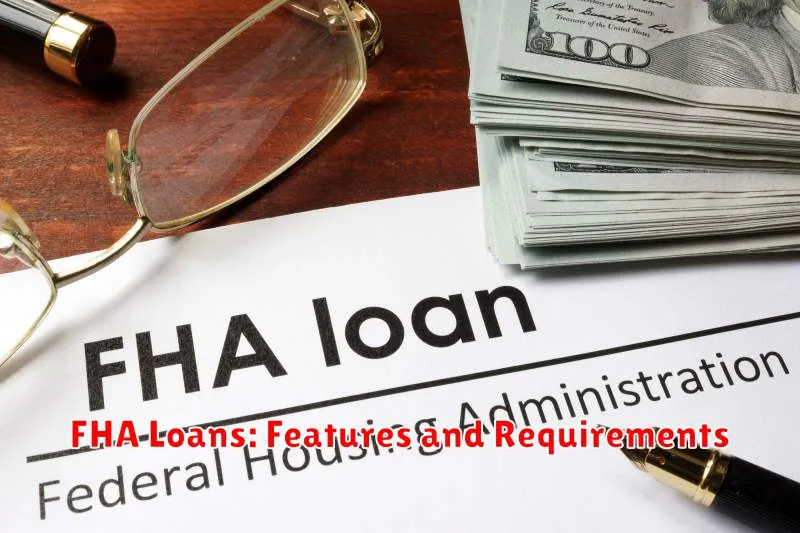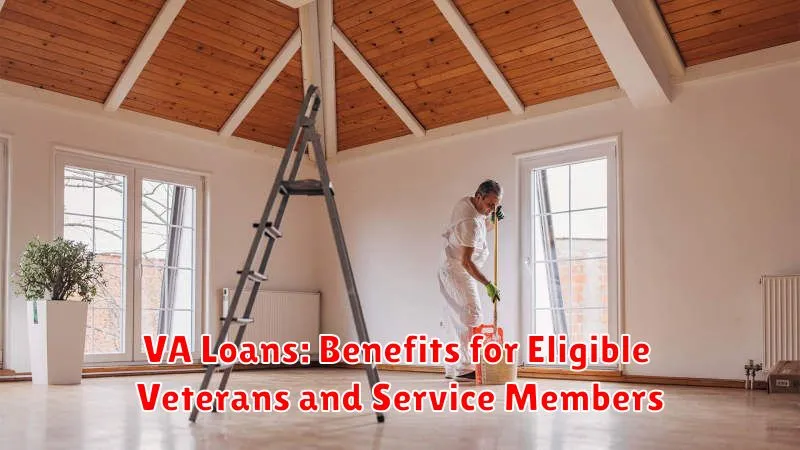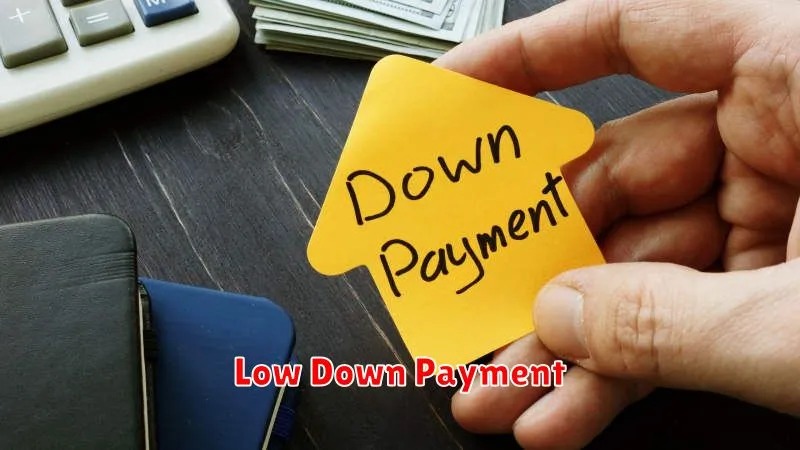The dream of homeownership is within reach, even if you don’t have a hefty down payment saved up. There are a variety of low down payment mortgage programs available that can help you achieve this goal. Whether you’re a first-time homebuyer or looking to upgrade, these programs offer flexible options to make your dream a reality.
Navigating the world of mortgages can be overwhelming, especially when it comes to understanding the different programs and requirements. This comprehensive guide will equip you with the knowledge you need to explore low down payment mortgage options and find the right fit for your financial situation. We’ll break down the details of popular programs, eligibility criteria, and the benefits they offer. Let’s unlock the door to homeownership together!
What is a Down Payment and Why It Matters
A down payment is the initial sum of money you pay upfront when buying a home. It’s a percentage of the total purchase price, and it typically comes from your savings. This upfront payment plays a crucial role in securing a mortgage and becoming a homeowner.
Why does it matter? A larger down payment typically translates into a lower monthly mortgage payment and a lower overall interest cost. By putting more money down, you borrow less, reducing the principal balance and saving you on interest.
A significant down payment can also improve your chances of qualifying for a mortgage and securing a lower interest rate. Lenders often perceive borrowers with larger down payments as less risky, leading to more favorable terms.
Benefits of Low Down Payment Mortgages
For many aspiring homeowners, saving up for a hefty down payment can seem like an insurmountable hurdle. Fortunately, there are several low down payment mortgage programs available that can make the dream of homeownership more attainable. These programs offer various advantages, making them a compelling option for those looking to enter the housing market without a large financial cushion.
One of the most significant benefits of low down payment mortgages is the ability to purchase a home sooner. By requiring a smaller upfront investment, these programs allow you to start building equity in a property without waiting years to accumulate a substantial down payment. This can be especially advantageous in a competitive housing market where prices tend to rise over time.
Another key benefit is the potential for lower monthly payments. Since you are borrowing a larger amount, your monthly mortgage payments may be slightly higher than with a traditional mortgage. However, the lower down payment allows you to qualify for a smaller loan amount, which can ultimately result in more manageable monthly expenses. This is particularly helpful for those with a tight budget or fluctuating income.
Low down payment mortgages can also provide access to government-backed programs, such as the Federal Housing Administration (FHA) and the U.S. Department of Agriculture (USDA) loans. These programs offer various benefits, including relaxed credit requirements, lower interest rates, and even down payment assistance. By leveraging these programs, you can significantly improve your chances of securing a mortgage and achieving homeownership.
Overall, low down payment mortgages offer a range of benefits that can make homeownership more accessible for a wider range of individuals. They allow you to enter the market sooner, potentially reduce monthly expenses, and benefit from government-backed programs. If you are looking to buy a home without the burden of a large down payment, exploring these programs can be a wise and rewarding move.
Types of Low Down Payment Mortgage Options
Securing a mortgage with a low down payment can be a game-changer for aspiring homeowners. Several mortgage programs are designed to help you achieve this goal, each with its own set of eligibility criteria and benefits. Here’s a breakdown of some popular low down payment mortgage options:
FHA Loans: Backed by the Federal Housing Administration (FHA), these loans are known for their flexible eligibility requirements and low down payment options. You can typically qualify with a down payment as low as 3.5%, making them an attractive option for first-time homebuyers and borrowers with less-than-perfect credit.
VA Loans: These loans are exclusively available to eligible veterans, active-duty military personnel, and surviving spouses. VA loans offer the benefit of zero down payment, although a funding fee may apply. This makes homeownership significantly more accessible for those who have served our country.
USDA Loans: Designed to promote homeownership in rural areas, USDA loans offer low down payments and competitive interest rates. In some cases, a zero down payment option might be available. To qualify, you must reside in an eligible rural area and meet specific income requirements.
Conventional Loans with Down Payment Assistance: Conventional loans are offered by private lenders but may require a higher down payment (typically 5% to 20%). However, some lenders and government programs offer down payment assistance programs that can help reduce your out-of-pocket expenses. These programs might have specific eligibility criteria and restrictions.
State and Local Programs: Various state and local governments offer programs aimed at promoting affordable homeownership. These programs might provide down payment assistance grants, tax credits, or other incentives to help eligible individuals purchase a home with a lower down payment.
Choosing the right low down payment mortgage option depends on your individual financial situation and needs. It’s essential to research the programs thoroughly, compare interest rates and fees, and consult with a qualified mortgage lender to determine the best fit for your circumstances.
FHA Loans: Features and Requirements

For first-time homebuyers or those with limited savings, FHA loans offer a path to homeownership with lower down payment requirements and flexible credit guidelines. Backed by the Federal Housing Administration (FHA), these loans are designed to make homeownership more accessible to a broader range of individuals.
Key Features of FHA Loans:
- Lower Down Payment: FHA loans typically require a down payment of just 3.5% for qualified borrowers, significantly less than conventional loans.
- More Lenient Credit Requirements: FHA loans have more flexible credit score requirements compared to conventional loans, making them accessible to individuals with less-than-perfect credit history.
- Mortgage Insurance: FHA loans require mortgage insurance premiums (MIP) to protect lenders against potential losses. MIP is paid throughout the loan term, either as an upfront premium or as a monthly premium.
- Flexible Debt-to-Income Ratio (DTI): FHA loans allow for a higher DTI, enabling borrowers with significant debt obligations to qualify for a mortgage.
FHA Loan Eligibility Requirements:
To qualify for an FHA loan, borrowers must meet certain criteria, including:
- Credit Score: While FHA loans have more lenient credit score requirements, a minimum credit score is typically needed, usually around 580 for a 3.5% down payment. Borrowers with credit scores between 500 and 579 may still qualify with a 10% down payment.
- Debt-to-Income Ratio (DTI): The DTI is the percentage of your monthly income that goes towards debt payments. FHA loans generally allow for a DTI of up to 50%.
- Stable Income: You must have a consistent and documented income history to demonstrate your ability to repay the loan.
- Down Payment: The down payment requirement for FHA loans is typically 3.5% of the purchase price. In some cases, you may be able to utilize a gift from a family member for the down payment.
- Property Eligibility: FHA loans are available for single-family homes, townhomes, condominiums, and manufactured homes. However, the property must meet FHA’s minimum property standards.
VA Loans: Benefits for Eligible Veterans and Service Members

For those who have served our country, the U.S. Department of Veterans Affairs (VA) offers a valuable program: VA loans. These loans provide a unique path to homeownership with numerous advantages for eligible veterans, active-duty military personnel, and surviving spouses.
One of the most significant perks is the ability to purchase a home with no down payment. This eliminates a significant financial hurdle, making homeownership more accessible. Moreover, VA loans typically offer lower interest rates compared to conventional mortgages, leading to substantial savings over the life of the loan.
Another key benefit is the lack of mortgage insurance, a common requirement for conventional loans. This further reduces the overall cost of borrowing and monthly payments. Additionally, VA loans offer flexible credit requirements, providing opportunities for veterans who may have faced credit challenges due to their service.
To qualify for a VA loan, individuals must meet specific eligibility criteria, including active duty service, veteran status, or membership in the National Guard or Reserves. The VA also sets limits on the loan amount, which vary by county and are based on local housing market conditions.
Overall, VA loans offer a compelling path to homeownership for eligible veterans and service members. By providing lower costs, flexible requirements, and access to financing without a down payment, these loans empower those who have served to build a stable future.
USDA Loans: Supporting Rural Homeownership
The U.S. Department of Agriculture (USDA) offers a unique mortgage program designed to help individuals and families achieve homeownership in eligible rural areas. This program, known as the USDA Rural Development Housing Loan Program, is specifically targeted at promoting homeownership in underserved communities, fostering economic growth, and improving quality of life in rural areas.
One of the most appealing features of USDA loans is the low or no down payment requirement. This makes homeownership a reality for many individuals who might otherwise struggle to accumulate a significant down payment. The USDA’s commitment to promoting rural development extends beyond just providing affordable financing. The program also prioritizes the development of affordable housing options, ensuring that homes are energy-efficient and meet the needs of diverse families.
The eligibility criteria for USDA loans are relatively straightforward, focusing on the location of the property and the borrower’s income. The property must be located in a designated rural area, and the borrower’s income must fall below certain limits. If you’re considering a home purchase in a rural area, exploring the USDA loan program is a wise step. It offers a valuable pathway to homeownership, empowering individuals and families to build a future in thriving rural communities.
Conventional Loans with Low Down Payment Options
Conventional loans are a popular choice for homebuyers because they generally offer lower interest rates than government-backed loans. However, they often require a substantial down payment of 20% of the purchase price. Thankfully, there are programs available that allow you to qualify for a conventional loan with a lower down payment, sometimes as low as 3%.
One such program is the Conventional 97 Loan. This program enables you to put down only 3% of the purchase price, while the lender covers the remaining 3% through mortgage insurance. This insurance protects the lender in case you default on your loan. However, mortgage insurance is a monthly expense that is added to your mortgage payment, so it’s important to factor this cost into your budget.
Another option is the HomeReady® program. This program is designed to help low- and moderate-income borrowers purchase a home. It allows for down payments as low as 3% and has flexible credit requirements. The HomeReady® program also offers features like down payment assistance grants and affordable mortgage rates.
It’s important to note that even with low down payment options, you will still need to meet certain eligibility criteria. These criteria can vary depending on the lender and the specific program you choose. It’s always a good idea to speak with a mortgage lender to discuss your individual circumstances and see which low down payment options are available to you.
State and Local Down Payment Assistance Programs
Many states and localities offer down payment assistance programs to help first-time homebuyers and low- and moderate-income families afford a home. These programs typically provide grants or forgivable loans that reduce the amount of money needed for a down payment. Some programs even offer closing cost assistance.
The availability and requirements of these programs vary widely by location. It’s important to research the programs available in your area and see if you qualify. You can contact your local housing authority or a reputable mortgage lender to learn more about the programs available in your area.
Here are some common types of state and local down payment assistance programs:
- Grant programs: These programs provide a direct grant that doesn’t need to be repaid.
- Forgivable loans: These loans are forgiven over time, often based on factors like length of residency or continued homeownership.
- Matching programs: These programs match a portion of your down payment savings, up to a certain limit.
State and local down payment assistance programs can make homeownership a reality for many people who might otherwise struggle to save for a down payment. If you’re considering buying a home, don’t overlook the potential benefits of these programs.
Eligibility Criteria for Low Down Payment Mortgages
Securing a mortgage with a low down payment can be a game-changer for aspiring homeowners, but it’s important to understand the eligibility criteria. These programs are designed to make homeownership more accessible, but they come with specific requirements that borrowers need to meet.
Here’s a breakdown of common eligibility criteria for low down payment mortgages:
Credit Score
A good credit score is crucial. Lenders generally prefer borrowers with a credit score of at least 620, but some programs may have slightly lower requirements. A higher credit score can often lead to better interest rates and loan terms.
Debt-to-Income Ratio (DTI)
Your DTI, calculated by dividing your monthly debt payments by your gross monthly income, plays a significant role. Lenders look for a DTI below a certain threshold, typically around 43%, to ensure you can comfortably manage your mortgage payments.
Income Verification
Lenders will verify your income through pay stubs, tax returns, or other documentation. Stable employment history and consistent income are important factors for approval.
Down Payment Savings
While low down payment mortgages require less upfront capital, you’ll still need to have a substantial down payment saved. The minimum down payment requirement can vary depending on the program.
Homebuyer Education
Some programs may require you to complete a homebuyer education course, which can provide valuable information about the home buying process and financial responsibilities.
It’s crucial to research the specific eligibility criteria of the low down payment mortgage programs you’re interested in. Consulting with a mortgage lender or financial advisor can provide personalized guidance based on your individual circumstances. Remember, meeting these criteria doesn’t guarantee approval, but it significantly increases your chances of securing a mortgage and achieving your dream of homeownership.
Navigating the Application and Approval Process
Once you’ve chosen a low down payment mortgage program, it’s time to start the application process. This can seem daunting, but it’s made much easier with the right guidance. The first step is to gather all the necessary documentation, including your income verification, credit history, and assets. It’s crucial to ensure your credit score is as high as possible before applying, as this will significantly impact your loan terms and interest rate.
After submitting your application, the lender will review your information and assess your ability to repay the loan. This process may involve a home appraisal and a property inspection. Be prepared for a thorough evaluation of your financial situation, including your debt-to-income ratio (DTI) and employment history.
Throughout the process, communication is key. Ask your lender questions, be proactive in providing any required documents, and keep track of all deadlines. By staying informed and engaged, you can streamline the process and increase your chances of getting approved for a low down payment mortgage.
Understanding Closing Costs and Fees
While low down payment mortgage programs make homeownership more accessible, it’s essential to understand the closing costs and fees associated with these loans. Closing costs are expenses incurred during the final stages of a real estate transaction, paid by the buyer to finalize the purchase. These costs can vary depending on the lender, property location, and other factors.
Here’s a breakdown of common closing costs:
- Loan origination fee: A percentage of the loan amount charged by the lender for processing your mortgage application.
- Appraisal fee: Paid to a professional appraiser who assesses the property’s value to ensure it meets the loan requirements.
- Title search and insurance: Covers the costs of reviewing the property’s history to ensure clear ownership and protects you against potential title claims.
- Property taxes and homeowners’ insurance: These are often escrowed into your monthly mortgage payments.
- Recording fees: Paid to the local government for registering the deed and mortgage.
It’s crucial to budget for these closing costs, as they can range from 2% to 5% of the loan amount. You can negotiate certain fees with the lender, such as the loan origination fee.
Understanding these fees will help you make informed financial decisions and avoid surprises during the closing process. By carefully evaluating and budgeting for closing costs, you can smoothly navigate the path to homeownership.
Pros and Cons of Low Down Payment Mortgages
Low down payment mortgages are a popular option for first-time homebuyers or those with limited savings. These programs allow you to purchase a home with a smaller upfront investment, making homeownership more accessible. While this can be a great advantage, it’s crucial to weigh the pros and cons carefully before making a decision.
Pros
- Lower upfront costs: The most significant advantage is the ability to purchase a home with less money down. This reduces the barrier to entry for many potential homeowners.
- Easier qualification: Some low down payment programs have more lenient qualification requirements, making it easier for individuals with lower credit scores or limited income to qualify.
- Potential for quicker homeownership: With less money saved for a down payment, you may be able to purchase a home sooner.
Cons
- Higher monthly payments: A smaller down payment typically translates into a larger loan amount, resulting in higher monthly mortgage payments.
- Private Mortgage Insurance (PMI): Most low down payment mortgages require Private Mortgage Insurance (PMI), which is an additional monthly cost to protect the lender in case of default. This can add a significant expense to your monthly budget.
- Potential for higher interest rates: Some low down payment programs may have slightly higher interest rates, leading to a more expensive mortgage in the long run.
- Less equity: A smaller down payment means you have less equity in your home initially. Equity is the difference between your home’s value and the amount you owe on the mortgage. Having less equity can make it harder to refinance or sell your home later on.
Choosing the Right Mortgage Program for You

Navigating the world of mortgages can be overwhelming, especially when you’re looking for low down payment options. But, with the right information, you can find the program that best suits your financial situation and helps you achieve your dream of homeownership.
Here are some factors to consider when choosing a mortgage program:
- Credit Score: Your credit score plays a significant role in determining the loan options available to you and the interest rate you qualify for. Higher credit scores typically lead to better rates.
- Down Payment: Low down payment mortgage programs are designed for those with limited savings. These programs typically require a down payment of 3.5% or less, but they may come with certain restrictions or requirements.
- Loan Type: There are various loan types available, each with its own advantages and disadvantages. Some popular options include conventional loans, FHA loans, VA loans, and USDA loans.
- Interest Rate: Interest rates fluctuate based on market conditions, your credit score, and the type of loan you choose. It’s crucial to compare rates from different lenders to secure the best deal.
- Loan Terms: The loan term refers to the duration of the loan, typically 15 or 30 years. Longer terms usually come with lower monthly payments, but you’ll pay more in interest over the life of the loan.
It’s essential to do your research, compare programs, and consult with a mortgage professional to determine the best fit for your individual circumstances. They can help you understand the nuances of each program, assess your eligibility, and guide you through the application process.

